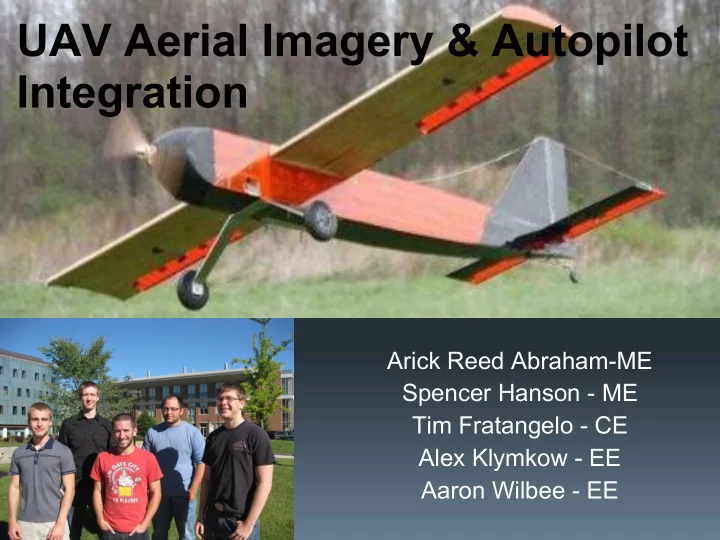

UAV Aerial Imagery & Autopilot Integration Arick Reed Abraham-ME Spencer Hanson - ME Tim Fratangelo - CE Alex Klymkow - EE Aaron Wilbee - EE
Agenda ● Project Background ● Desired State ● Obstacles ● Project Plan
Team Name Role Picture Arick Reed Abraham ME / Coordinator Team Spencer Hanson ME Tim Fratangelo CE Alex Klymkow EE Aaron Wilbee EE
Project Background ● Imaging Science Department needs to take aerial Images ○ Currently done with full-scale aircraft ○ High cost, infrequent flights ● UAVs significantly reduce operational costs and pilot risk ○ Proper configuration for successful operation by less- experienced users ○ Easy to source replacement parts
Previous Projects ● P13231 ○ UAV Wireless ● P10231 Communication and Control ○ UAV Telemetry ● P11562 ● P09561 ○ Modular Imaging System ○ Visible Spectrum Imaging Frame and Stabilization System ● P11232 ● P09233 ○ UAV Airframe C.1 ○ Airframe Measurement and ● P11231 Aircraft Controls ○ UAV Image Integration and ● P09232 Performance ○ UAV Airframe B ● P10661 ● P09231 ○ Image Calibration Device ○ UAV Airframe A ● P10236 ○ Configurable control platform ● P10232 ○ UAV Airframe C
Current State ● Imaging Science still using hired aircraft for aerial photography. ● Previous efforts have produced discrete systems. ● Airborne imaging system previously developed, likely antiquated. ● Existing payload-bearing aircraft requires more testing. No fully integrated UAV imaging platform exists
Desired State ● Full integration between airframe, autopilot, and imaging systems. ● A UAV capable of autonomous waypoint-directed flight. ● Integrated imaging system capable of taking and saving photos ● Real-time control through the ground station. ● On-demand transfer of control to a human pilot.
Stakeholders ● Dr. Jason Kolodziej ● RIT Imaging Science Department ● MSD Team ● Innocent Bystanders
House of Quality Maximum Energy Aircraft Powerplant Functional Priority Output Sufficient Stability Functional Autopilot Communication Link Camera Module Autopilot follow Dynamically 1 updating Waypoints 9 x 2 FAA Compliance 9 x x Meaningful Mission 3 Time 9 x x GPS Triggered 4 Image Capture 9 x x 5 Functional Aircraft 9 x x x Ground Station 6 Update Waypoints 3 x Receive Telemetry 7 and display 3 x Ground Station 8 Image Capture 3 x Record Inertial 9 Position 3 x Modular Camera 10 Mount 3 x Measure KWH KW BFT BFT BFT BFT
Objectives ● Stable reusable aircraft ● Control strategy/algorithms ● Interchangeable camera equipment ● Accurate information recording
Deliverables ● Functional autonomous small (test) aircraft ● Functional payload bearing (X-4) aircraft with: ○ Integrated autopilot ○ Integrated imaging hardware payload ● Ground station software ● Autopilot software ● Image capture software
Assumptions ● The team has adequate ability to complete the project. ● Previous projects are functional but require testing ● Budget $1000 ● Replacement of camera equipment
Risks ● Any flight failure will probably require at least some aircraft repair, taking multiple days. ● Pilot availability: There are no pilots on the team skilled enough to fly the large aircraft for testing. ● Communication failure for manual control ● Safety of fragile parts (camera, micro controller) ● Part replacement lead time.
Benchmarking ● Precedence with ArduPilot™, popular with amateurs ● Previous Senior Design team successes/failures ● Existing technology and expertise from model aviation ● Comparison to professional technology neither practical nor possible.
Next Steps ● Prepare the small (test) airframe ● Confirm the state of the imaging equipment ● Determine specifications for next iteration of imaging equipment ● Validate design of the UAV X-4’s control surfaces against theoretical models
Questions
Recommend
More recommend